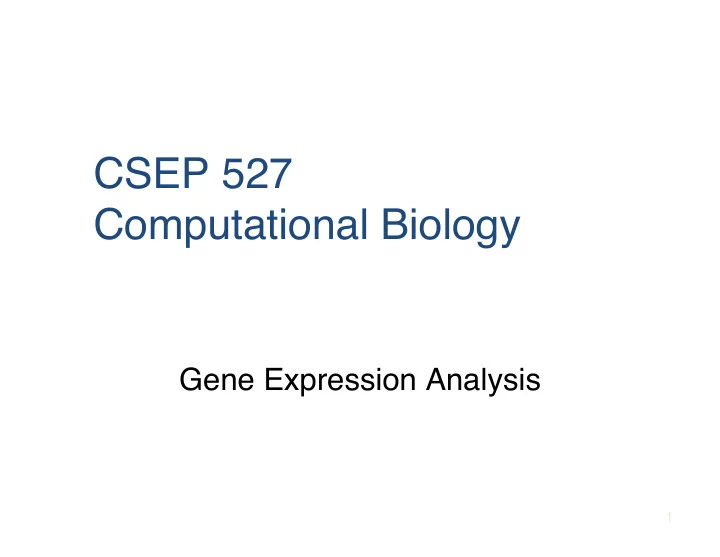

CSEP 527 Computational Biology Gene Expression Analysis 1
Assaying Gene Expression 3
Microarrays 4
RNAseq Millions of reads, DNA Sequencer say, 100 bp each map to genome, analyze 5
Goals of RNAseq #1: Which genes are being expressed? How? assemble reads (fragments of mRNAs) into (nearly) full-length mRNAs and/or map them to a reference genome #2: How highly expressed are they? How? count how many fragments come from each gene–expect more highly expressed genes to yield more reads, after correcting for biases like mRNA length #3: What’s same/diff between 2 samples E.g., tumor/normal #4: ... 7
Recall: splicing exon 5 � intron exon 2
RNAseq Data Analysis De novo Assembly mostly deBruijn-based, but likely to change with longer reads more complex than genome assembly due to alt splicing, wide diffs in expression levels; e.g. often multiple “k’s” used pro: no ref needed (non-model orgs), novel discoveries possible, e.g. very short exons con: less sensitive to weakly-expressed genes Reference-based (more later) pro/con: basically the reverse Both: subsequent bias correction, quantitation, differential expression calls, fusion detection, etc. 8
“TopHat” (Ref based example) n map reads to ref transcriptome (optional) BWA n map reads to ref genome n unmapped reads remapped as 25mers n novel splices = 25 mers anchored 2 sides n stitch original reads across these n remap reads with minimal overlaps n Roughly: 10m reads/hr, 4Gbytes (typical data set 100m–1b reads) 9
Kim,et al. 2013. “TopHat2: Accurate Alignment of Transcriptomes in the Presence of Insertions, Deletions and Gene Fusions.” Genome Biology 14 (4) (April 25): R36. doi:10.1186/gb-2013-14-4-r36. Figure 6
RNAseq Example 1yr-3 hg19 5 kb Scale chr19: 50,020,000 50,025,000 Day 20 1 Year FCGRT FCGRT 20
RNAseq protocol (approx) Extract RNA (either polyA polyT or tot – rRNA) Reverse-transcribe into DNA (“cDNA”) Make double-stranded, maybe amplify Cut into, say, ~300bp fragments Add adaptors to each end Sequence ~100-175bp from one or both ends CAUTIONS: non-uniform sampling, sequence (e.g. G+C), 5’-3’, and length biases 6
Recommend
More recommend